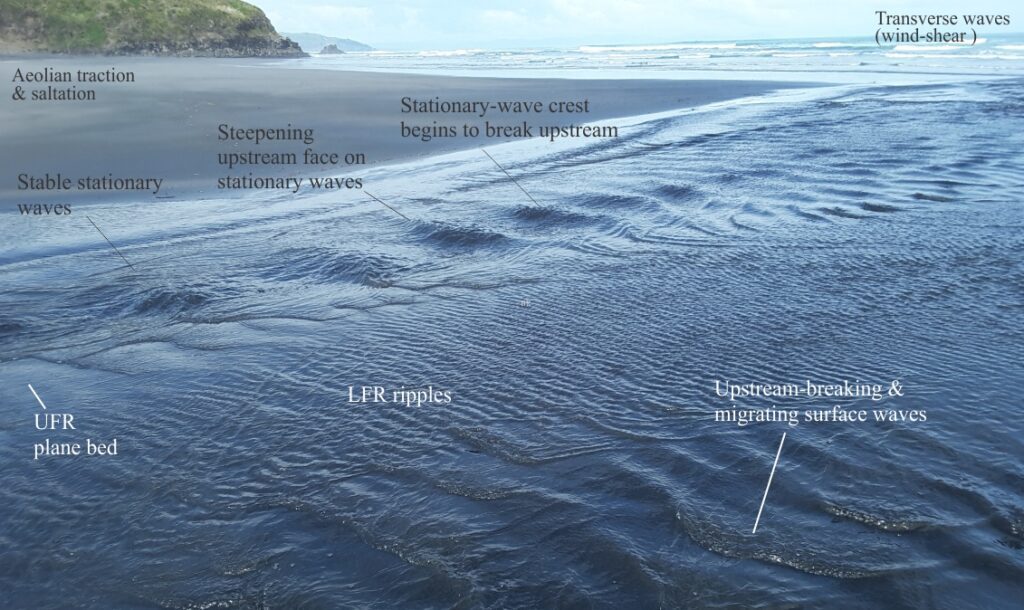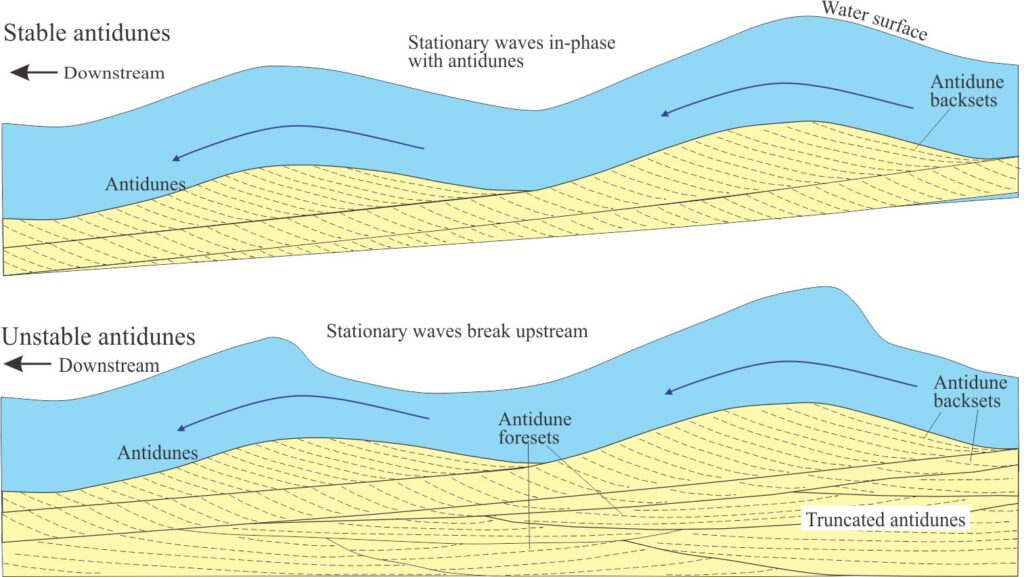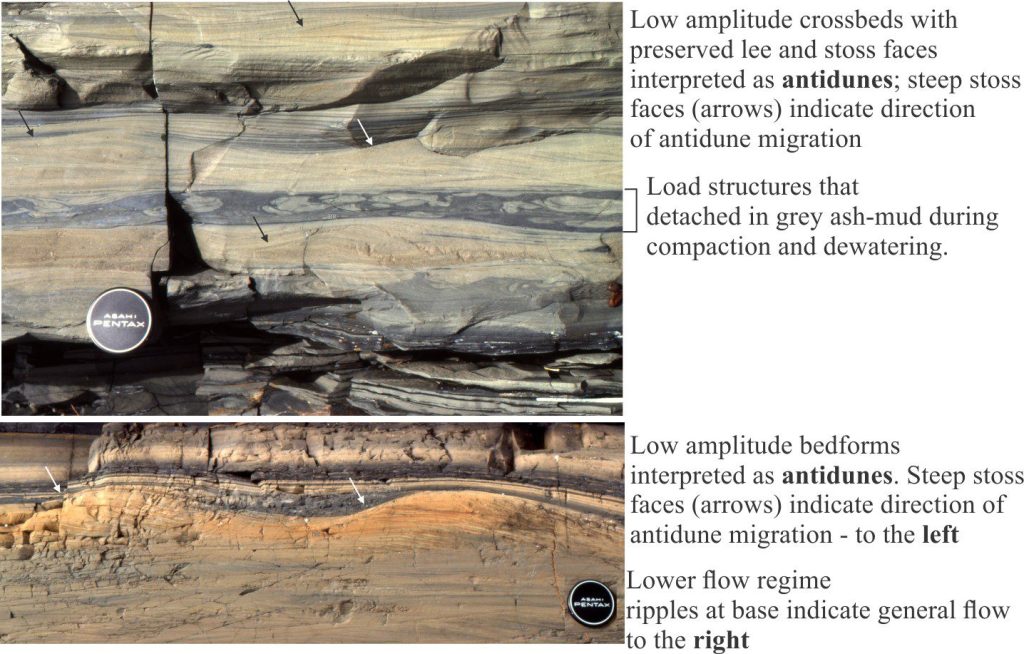

Shallow flow across a beach at low tide – a natural flume. Flow is differentiated into upper (UFR) and lower flow regimes (LFR). The primary focus in the image is the different stages of development and stability for the stationary waves. Other components of the broader depositional setting are also noted. Raglan, New Zealand.
Upper flow regime bedforms and processes
Use this link to read the introduction to the lithofacies series.
Preamble
Despite the burgeoning interest in upper flow-regime (UFR) bedforms and the hydrodynamic processes that create them, the recognition of these structures in outcrop remains a source of sedimentological frustration. We frequently explain their apparent paucity in the rock record as a problem of low preservation potential – “they tend to be washed out during the transition to lower flow regime conditions“. Not a quote by anyone in particular but it summarizes the general feeling about the problem. Fielding (2006) on the other hand intimates that we haven’t been paying attention. Perhaps we haven’t been looking hard enough!
For a given grain size and at increasing flow velocities above those that form upper plane bed, the flow surface changes from stationary waves that are capable of migrating upstream (also called standing waves), to chute and pool, followed by cyclic steps. Flows that decrease to lower flow regime pass through a hydraulic jump. For all these flow conditions there is a corresponding response at the sediment-water interface. Beneath the stationary waves are antidunes where both the water surface and bedforms are in-phase (or close to it); these bedforms are well known, at least in modern natural and experimental flow systems. Antidunes may be stationary, migrate upstream or migrate downstream. But there is a big question mark about the sedimentary response to cyclic steps, chute and pool, and hydraulic jumps, particularly in the context of their representation in outcrop.
This post looks at the antidune part of the hydraulic spectrum.
External structure
Antidunes are bedforms. In fine- to medium-grained sandstone and volcanic ash they superficially resemble low amplitude ripples and dunes; amplitudes are commonly measured in millimetres to a few centimetres depending on flow conditions, and corresponding wavelengths in centimetres to a few metres (the latter in large river floods). In cross-section their profiles range from symmetrical to asymmetrical forms where the steep face is on the upstream side of the bedform (stoss face). In modern channel flows and in flumes, antidunes frequently occur in trains although the symmetry and steepness of successive bedforms may change down flow.
Note that the terms stoss (upstream) and lee (downstream) apply to UFR (Froude supercritical) bedforms, as they do for LFR bedforms (ripples, dunes).
Internal structure
Antidune crossbedding can vary from:
- Continuous symmetrical and asymmetrical laminae on the upstream and downstream bedform surfaces, such that laminae conform approximately to the antidune surface,
- Low-angle Upstream-facing, or stoss backsets – this is one of the more recognisable characteristics of antidune crossbedding
- Low-angle foresets inclined downstream (lee foresets).
- Sinusoidal laminae that extend from the antidune crest to the adjacent trough.
Lamina dips are generally <10o to 12o for both upstream- and downstream-facing foresets; in comparison, lower flow-regime ripple and dune foreset dips are usually >15o and only occur on the lee surface.


Diagramatic presentation of antidune bedforms in stable and unstable conditions, originally drawn from flume experiment images by Cartigny et al., 2014. This diagram is modified from their Figure 3. In both panels, flow is to the left.
The preserved form of antidunes in outcrop is variable. In some, the complete antidune outline is preserved (either symmetrical or asymmetrical), and it may be possible to trace the depositional surface between adjacent antidunes. However, truncated foresets can also occur resulting in lenticular or lozenge-shaped units – an indication that successive antidunes have migrated along the depositional surface, eroding earlier-formed structures (a process analogous to many LFR bedforms). The two different outcrop expressions may reflect a change in antidune stability (discussed briefly below).
Antidune crossbedding also occurs with parallel laminated, upper plane-bed laminated sandstone deposits.
Formation – hydrodynamic behaviour
Open channels (and flumes)
Antidunes form at the transition from subcritical flow (Froude number <1) to supercritical flow (Froude >1). At this transition, surface waves are in-phase with the bedforms. During upper flow regime flow there is a progression in stationary wave and bedform behaviour.


Summaries of the hydraulic conditions for deposition of upper flow regime bedforms, compared with other bedforms. Data for the graphical plots is mostly from flume experiments. The Froude supercritical region is from Cartigny et al., 2014:
1- Flow Regime (left); after J.C. Harms & R.K. Fahnestock, 1965,
2- Bedform stability fields in relation to median grain size and mean current velocities (centre); modified from Ashley, G.M. 1990,
3- Reynolds and Froude numbers as a function of flow depth and flow velocity (right); modified slightly from J.R.L. Allen,1992, Fig. 1.21.
Upper flow regime – supercritical fields are indicated in bold red type.
The initial, stable form of a stationary wave results in erosion of sand from the lee face (downstream) and deposition on the upstream stoss face. The depositional outcome is a series of upstream-dipping backsets. The stationary waves migrate upstream in concert with the formation of backset laminae. Preservation of the backset laminae depends on the amplitude of successive overlying antidunes and the depth they erode, and also on the rate of aggradation during deposition (Cartigny et al., 2014 – PDF available).
Stationary waves that break upstream have become unstable. Cartigny et al., 2014 provide a good description of the processes taking place. Deposition of backset laminae gradually steepens the antidune and corresponding upstream face of the stationary wave to the point where it becomes gravitationally unstable. The breaking wave surges upstream, carrying with it sand in suspension (eroded from the underlying antidune) that is subsequently deposited in the adjacent trough. This results in a loss of energy and a temporary decrease in flow velocity. The mass of water carried by the surge eventually flows downstream, whereupon flow returns to a critical – supercritical condition and the process of antidune formation begins anew.
The transition from stable to unstable stationary waves results in truncation of the underlying antidune. The truncations result in discontinuous laminae and more lenticular or lozenge-shaped foresets and backsets. The transitions from stable to unstable waves are repeated as long as UFR conditions are maintained.
If you have the opportunity to observe shallow stream flow across a beach, you will see endless repetitions of stationary wave growth, breaking waves and upstream surges, decay of flow as the surge moves downstream, followed by renewed stable stationary wave buildup. An example of the kind of bedform stratigraphy one might expect from these transitions is shown in the diagram above.
Antidunes and other bedforms created by supercritical flow also occur in turbidites and dilute pyroclastic flows (pyroclastic surges), where the depositional medium involves sediment kept in suspension by turbulence – cold and hot fluid turbulence respectively.
Turbidites


Two outcrops of redeposited, fine ash-sized clasts with examples of possible antidune bedforms; both units are sandwiched between volcaniclastic turbidites (not shown here). In both sections, lower flow regime ripples and climbing ripples indicate general flow to the right. In the upper panel, backset laminae, and stoss faces that dip at steeper inclinations that the opposing lee faces, indicate possible antidune migration to the left – opposite that of the turbidite flow direction. A similar situation exists in the lower panel, but here the antidune morphology is nicely preserved. These examples are from the Paleoproterozoic Flaherty Formation, Hudson Bay.
The laminated B division in turbidites (using the Bouma terminology) is generally considered to form in UFR plane bed turbulent flow. The fundamental difference between the bedforms in open channels and turbidites is that UFR conditions must be maintained as sediment in the latter is deposited from turbulent suspension. The idea that UFR conditions play a significant role in the development of submarine channels and submarine fans, particularly their proximal sectors, has gained traction with the advent of high definition, multibeam bathymetry (e.g. Hodgson et al., 2022 – PDF available). An increasing number of publications identify antidune-like structures in turbidites although in some cases the distinction between these bedforms and LFR subaqueous dunes or ripples is not always clear. Nevertheless, we can have some confidence in the interpretations where crossbed sets contain low-angle laminae backsets and foresets and are associated with upper plane bed lamination.
Pyroclastic surges
Upper flow regime conditions are prevalent in pyroclastic surges where volcaniclastic debris (ash, lapilli, blocks) is kept in turbulent suspension with a hot fluid phase (mostly superheated steam) by shear along the top and basal flow boundaries. Like any turbulent sediment gravity flow, deposition begins when particles lose momentum. Supercritical conditions are likely because flow velocities are 10-100 times those seen in open channel flow (and in flumes). Under these conditions, the preservation of low-angle backsets (stoss) and foresets (lee), and commonly the morphological bedform outline is consistent with antidune formation. More complex crossbed geometries are also common, where lenticular lamina sets are bound by truncation surfaces. Steeper, scour-like erosional surfaces may indicate the transition to chute and pool conditions or to hydraulic jumps where flow velocity has decreased to subcritical velocities.


Pyroclastic surge deposits with small dune-like bedforms and possible antidunes with backset laminae indicating migration to the left, opposite to the main flow direction. Parallel lamination in the lower part of the section may also reflect upper plane bed conditions. La Breña, Mexico. Image credit: Jim Luhr, 1988, Smithsonian Institution
Common environments
Antidunes and associated UFR bedforms are common in many modern open channel flows. The potential for antidune preservation probably depends on bedform aggradation rate (the higher the better), burial rate, and flow deceleration rates. They can occur in siliciclastic, carbonate, and volcaniclastic deposits:
- Open and confined (subglacial) glacial outwash channels (Lang et al., 2021, Open Access
- Fluvial and alluvial fan channels, particularly those subject to flash floods and rapid deceleration,
- Sandy beaches in the swash-backwash zone,
- Turbidites and submarine channels (e.g., Cornard and Pickering 2019 PDF; Lang et al., 2017, PDF,
- Pyroclastic surges and other pyroclastic density currents where flow has been segregated by dilution of suspended particles (e.g. Dufek et al., 2016 – PDF).
Other posts in this series
Sedimentary lithofacies – An introduction
Ripple lithofacies: Ubiquitous bedforms
Ripple lithofacies influenced by tides
Tabular and trough crossbed lithofacies
Laminated sandstone lithofacies
Low-angle crossbedded sandstone
Hummocky and swaley cross-stratification
Lithofacies beyond supercritical antidunes
Subaqueous dunes influenced by tides
Introducing coarse-grained lithofacies
